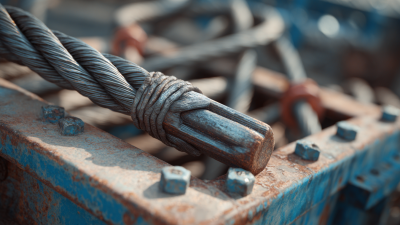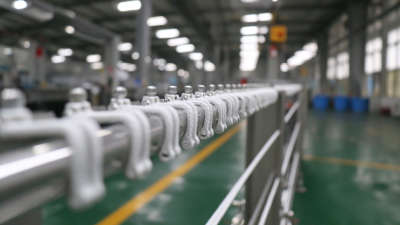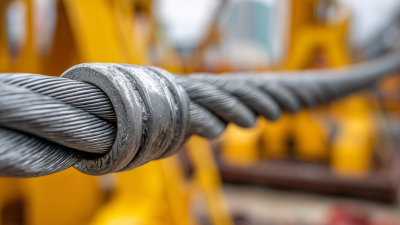In the realm of electrical installations, the efficiency of cable laying is paramount, with a significant focus on minimizing downtime and maximizing operational output. According to a report by the National Electrical Contractors Association (NECA), optimizing cable installation can reduce project timelines by up to 30%. A critical component in this process is the use of Wire Pulling Heads, which are specifically designed to facilitate the smooth movement of cables through conduits. These specialized tools not only improve the ease of installation but also help prevent damage to sensitive cables, thereby ensuring safety and reliability.
Furthermore, industry analyses indicate that the integration of advanced Wire Pulling Heads can lead to substantial cost savings. For instance, a study conducted by the International Wire and Cable Symposium reveals that using high-quality pulling heads can reduce cable-related failures by as much as 20%, translating to lower replacement costs and enhanced performance. As the demand for efficient and dependable cable installation methods continues to rise, understanding the intricacies of Wire Pulling Heads becomes essential for electrical contractors seeking to stay competitive in a rapidly evolving market. The innovations in this area promise to unlock new possibilities for streamlined operations and improved project outcomes.

Wire pulling heads are crucial components in the cable installation process, streamlining the often labor-intensive task of routing cables through conduits and other types of pathways. According to a report by the National Electrical Contractors Association (NECA), employing the correct tools and heads can reduce installation time by up to 30%, ultimately lowering labor costs and increasing project efficiency. These devices are designed to grip cables securely, minimizing the risk of damage during the pulling operation, which can lead to costly delays and reworking if the cables are compromised.
In addition to their efficiency benefits, understanding the essentials of wire pulling heads also involves recognizing the various types available on the market. As highlighted in industry studies, the choice between different materials—such as steel or aluminum—and designs—like conical or barrel shapes—can significantly affect performance. For instance, a study by the International Association of Electrical Inspectors indicates that using the appropriate pulling head can extend the lifespan of cables by preventing excess strain and wear. With advancements in technology, wire pulling heads are becoming increasingly sophisticated, integrating features that enhance grip strength and minimize friction during installation, making them an indispensable tool for modern electrical work.
Selecting the right wire pulling head is crucial for ensuring efficient cable installation, particularly when dealing with varying cable types. Different cables, ranging from coaxial to fiber optic, require specific characteristics in a wire pulling head to minimize damage and enhance performance. A well-chosen pulling head can significantly reduce friction during the installation process, enabling smoother and faster pulls without compromising the integrity of the cable.
Understanding the unique requirements of your cable type is essential. For instance, lighter cables may benefit from heads that are designed for less aggressive pulling, while heavier cables might necessitate more robust designs that can withstand greater strain. Additionally, features such as compatibility with various pulling techniques and the ability to grip cables without causing insulation damage are key factors to consider. By carefully analyzing the specifications of both your cable and potential pulling heads, you can optimize your installation process and achieve better outcomes.
Effective wire pulling is crucial for ensuring efficient cable installation in various industries, including telecommunications and electrical engineering. According to the National Electrical Contractors Association (NECA), cable installation accounts for nearly 30% of construction labor costs. Implementing advanced techniques for effective wire pulling can significantly reduce these costs and project timelines. For instance, using specialized wire pulling heads can enhance the initial pull, resulting in smoother transitions through conduits and reducing friction, which can lead to potential damage to the cables.
Maximizing efficiency with wire pulling heads involves several key techniques. First, employing a proper pulling tension, as recommended by the American National Standards Institute (ANSI) standards, can prevent cable sheath damage and ensure optimal cable performance. Reports indicate that using the correct pulling head can increase installation speed by up to 25%, allowing projects to meet tighter deadlines without compromising quality. Furthermore, ensuring that the wire pulling heads are compatible with the specific cable type and size enhances the overall reliability of the cable installation process, lowering the risk of future maintenance issues and enhancing long-term performance.
When it comes to efficient cable installation, understanding pulling tension is crucial. According to the National Electrical Contractors Association (NECA), adhering to standard pulling tension guidelines ensures optimal performance and minimizes risks associated with cable damage.
The guidelines typically recommend a maximum pulling tension of 2.5 to 3.0 times the cable's weight for a single pull, which helps maintain the integrity of the insulation and reduces the likelihood of conductors breaking.
Moreover, the American National Standards Institute (ANSI) emphasizes the necessity of calculating pulling tension based on various factors, such as cable size, length, and environmental conditions. For instance, a recent industry report highlighted that improper tension calculations can lead to failures, resulting in repair costs that can be as high as 20% of the total project budget.
Accurate tension calculations not only promote safety but also enhance the overall efficiency of cable installations, underlining the importance of following these industry standards closely.
When selecting materials for wire pulling heads, durability and reliability are paramount. Recent reports indicate that using high-density polyethylene (HDPE) can significantly enhance the performance of wire pulling heads. According to a study published by the International Wire & Cable Conference, HDPE exhibits superior resistance to abrasion and impact compared to traditional materials like PVC. This makes it an ideal choice for harsh installation environments, where wear and tear can lead to costly downtime and replacement.
Additionally, the importance of weight and flexibility cannot be overlooked. A detailed analysis from the Electrical Contractors Association shows that wire pulling heads made from lightweight aluminum alloys provide both strength and maneuverability. These materials not only reduce the overall load during installation but also facilitate smoother cable feeding, minimizing friction and potential damage to the cables. With up to 30% less weight compared to steel alternatives, aluminum pulling heads allow for easier handling without compromising structural integrity, ensuring a reliable installation process.






